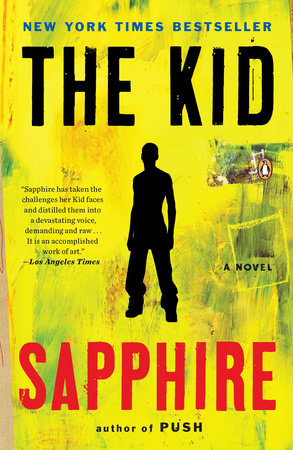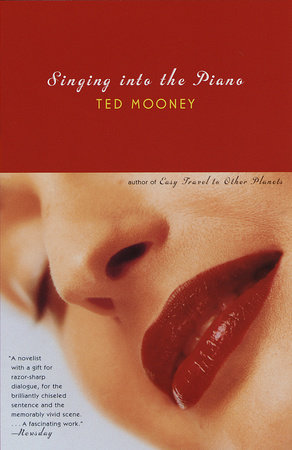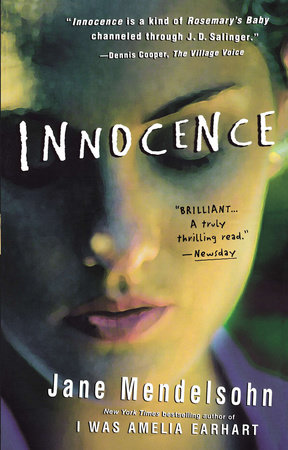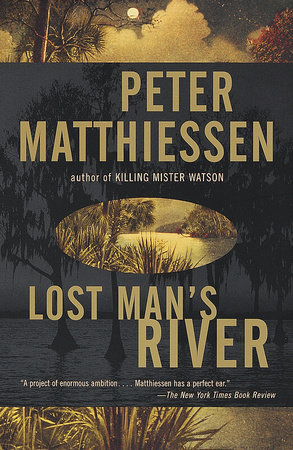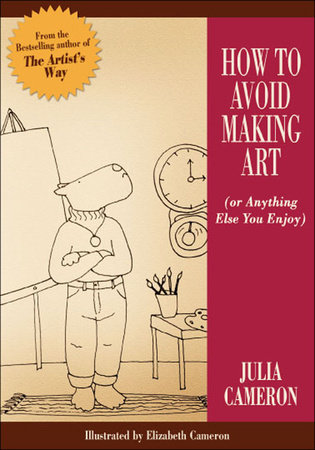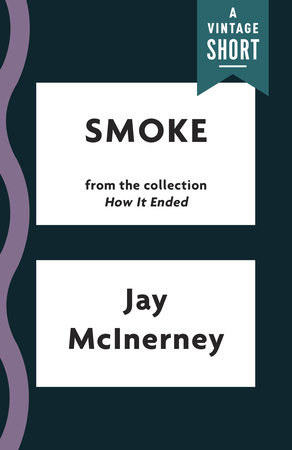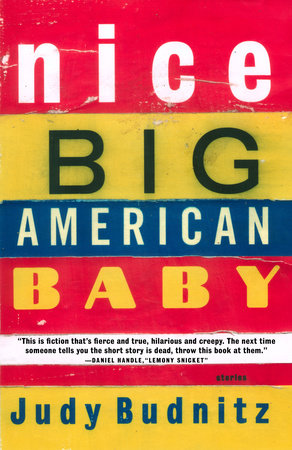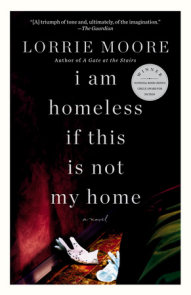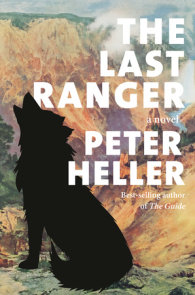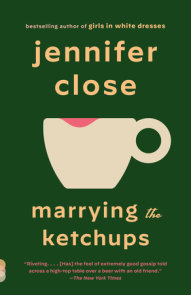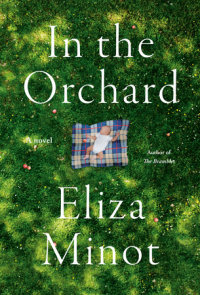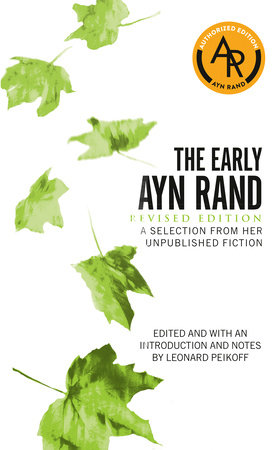Author Q&A
A Conversation with Judy Budnitz
Q: What does the title Nice Big American Baby mean, and why did you choose it for the collection?
A: The title is taken from the first story in the book, a story about a pregnant woman who is determined to sneak across the border and have her baby on American soil. She tries again and again, and keeps telling herself she wants to have a “nice big American baby.” It becomes her mantra, her obsession. She goes to absurd, extreme lengths to accomplish this goal. But there are other stories in which the potential to have a baby, or the notion of a lost baby, hovers like a ghost over the proceedings. And I think the title applies to certain stories in a more metaphorical way–the ones that are about characters who are well-intentioned and “nice,” but also stubborn and willfully ignorant: big babies, if you will. Many of the stories are about people who are eager to help others, but only on their own terms, so they often end up causing more harm than good.
“American” is such a loaded word, constantly evolving; and lately it seems to be evolving more rapidly than ever. “American” now has connotations I don’t think it had just a few years ago. Maybe there was once a time when you could put “nice” and “American” in the same phrase with all sincerity; now it’s impossible to do it without a whiff of skepticism. And “big”, too, seems to change subtly when you put it next to “American”: neutral or positive words suddenly take on other, darker connotations.
Q: Though the book’s title references America, these stories range across a wide variety of geographic and cultural terrains, seemingly a variety of countries. And yet you identify none of them by name. Why did you choose to do this?
A: In some cases I felt that naming specific countries would limit the stories. In the title story, I felt that saying the protagonist was Mexican might confine the story, and her character, to more narrow parameters; I wanted the woman to represent any woman (or man) from any country who goes to extreme lengths to enter the U.S. and partake in her idea of the American dream.
I also wanted to remain true to the ideas, without necessarily staying true to the facts–to take advantage of the assumptions that readers have about a certain part of the world without having to worry about inaccuracies. For example, there’s a story in which a man acquires a mail-order bride from an unspecified war-torn eastern European country. The American characters in the story complain that they can’t remember the name of the woman’s homeland, it’s too hard to spell; they’re not sure exactly where it is, and it doesn’t seem quite real to them. I think a lot of us feel the same way about much of the world–it seems nothing more than a series of depressing images on the TV news. I wanted to allow readers to fill in the gaps in the woman’s past with their own associations, their own images, of Bosnia or elsewhere.
I did this with historical periods as well as geography. There’s one story presumably set during the American Civil War; there’s another that’s a sort of parody of colonial attitudes, set in a southeast Asian country around the turn of the century. And there’s another story set in a southern American town in which desegregation tensions coexist with a summertime polio scare. I don’t know if, historically, these two events occurred within the same time period. I suspect they didn’t. But it made a deeper sort of sense to me to put them together in a story–two widespread panics both having to do with the fear of contact and contamination. Then I found myself seeing a series of events happen in and around the cool blue of a swimming pool in June.
Q: The mail-order bride story, “Nadia,” is told from the point of view of a group. Why did you choose to use a collective narrator?
A: I’ve always been interested in the collective “we” narrating voice. It can be a very powerful thing: frightening, like a mob speaking with one voice. And with this story, I was thinking about the mob mentality, trying to understand the way a mob is capable of doing things that the individuals within it would never do on their own. I wanted to have a narrator who’s sort of caught up in the mob thinking, at times inciting it and at other times trying to separate herself from it. And I wanted this to be a believable, contemporary sort of mob–the Salem witch-hunters of today. I wanted them to be ordinary, not-evil, somewhat sympathetic people, held together by petty emotions like jealousy and loneliness. So I landed on the idea of having the nosy, gossipy platonic friends of the protagonist narrate the story.
Q: What was the inspiration for the story “Saving Face,” in which an ordinary woman discovers that her own face is identical to the ubiquitous portrait of her country’s prime minister?
A: This story is set in a country in which the face of the ruling dictator is a constant presence, looming over people’s lives, appearing on everything from giant billboards to children’s coloring books. The face seems to take on a life of its own. The reference is obviously to Big Brother in 1984, or Mao, or Stalin, or a host of other examples. But actually, I first started thinking about this idea during the start of the invasion of Iraq. Every time you turned on the news you saw statues being torn down or Iraqis beating their shoes against a
picture of Saddam Hussein. It got me thinking about the power invested in these images, and how strong their hold can be and at the same time how quickly that power can be stripped away. I was thinking about advertising images as well–the way that the very pervasiveness of an image–a logo, a cartoon character–can accumulate a huge amount of power. I like to draw as well as write, and the idea of writing a story that was dominated by a single visual image–this face–was intriguing to me.
At the same time that Saddam statues were being torn down, the hunt was on for the man himself, and there was a lot of talk about his doubles, and whether soldiers would be able to distinguish the impersonators from the real thing. I began thinking about these doubles, but in a more ordinary context, wondering: what would it feel like to look exactly like someone else? What if it was someone you hated? Would you hate yourself when you looked in the mirror? Would your friends and family subconsciously despise you? What if you were forced to impersonate that despised person, forced to accept his punishments and deal with the consequences of his actions?
A face is an astonishingly powerful thing. I was reminded of that again during the recent Ukrainian elections. Victor Yushchenko’s face played such an important role, both symptom and symbol.
Q: In “Miracle” a white couple gives birth to a baby with startlingly black skin: “coal black, ink black,” as the father says. How did you come up with such a daring idea?
A: One of the inspirations for this story was the changeling myth. It’s an archetype that appears often in fairy tales and folk tales: goblins steal a human baby and replace it with a false one–an inanimate object, or a goblin baby. So I was thinking about this changeling idea, and I decided I would take that idea and reverse it: instead of the baby changing, I would have the baby stay more or less the same, and have the parents be the ones to change. That was the seed of the story. The parents’ perceptions of each other change; new sides of their personalities, which they’ve never before revealed, now are forced to the surface.
Another starting point for the story was that I wanted to address the issue of racism. Not just white/black prejudices, but general fears and suspicions of those who seem different. I wanted to portray characters who are politically correct in their ideas, who don’t consider themselves prejudiced, and yet find themselves bewildered when faced with the reality of a child who looks nothing like them. They don’t know how to act, what to do, they don’t know how to deal with the situation, or even how to talk about it. I wanted to explore that gap between ideas and reality, between good intentions and day-to-day behavior. And I saw the potential for humor in the situation: the awkward pauses; the shockingly inappropriate things that pop out of people’s mouths at unguarded moments; the clumsy attempts to smooth over gaffes.
But the story’s not just about race. It’s about the more general strangeness and mystery of giving birth, of bringing a new human being into the world and a new little stranger into your house. The story’s about all the new-mother fears: fears of not loving enough, or in the right way; fears that something is horribly wrong with your child and no one will acknowledge it; fears that your life will irrevocably change in ways you could not have predicted.
Q: Many of the stories are constructed around magical or surreal events. Do you consider yourself an experimental writer?
A: I think in many ways my writing is pretty traditional. I try to write the sort of thing that I like to read. And when I’m reading, I like to get totally lost in a story. I like to forget I’m reading words on a page and just experience the story as if it’s really happening. And to do that as a writer, to suck a reader into a fictional world like that, you need to write a compelling plot, create sympathetic, believable characters who act and talk like warm-blooded humans; you need to create a world full of vivid sensory details; you need to keep pulling the reader along with tension, mystery, suspense, emotional involvement. And all of these elements are standard elements of traditional fiction. I think the reason my fiction often gets described as “surreal” or just plain “weird” is my choice of subject matter. I like to write about things that don’t, or can’t, or won’t, happen in real life. I like putting realistic characters in unrealistic situations. Magical or horrific or impossible things might happen in my stories, but the characters are always guided by the same human emotions that we all share.
Q: “Preparedness” imagines rapture as the response to a looming apocalypse, and it seems to echo, in a darkly funny way, the world’s current political climate. Were you aiming for a political message in that story, or in the book as a whole?
A: I didn’t intend for this book to be political. When I wrote the stories, I was simply writing what was foremost in my mind. I’ve always liked writing about people facing moral questions. I like exploring human behavior, trying to suss out why people treat each other as they do. I’m not offering any grand global solutions. I’m more interested in simply making a reader wonder, “what would I do in that situation?” I think good stories are the ones that keep you entertained and engaged so that you don’t notice the themes and messages being slipped in between the lines.
As for “Preparedness,” I set out to write it years ago, almost as a lark, just for the fun of creating a cartoonish president. I meant it to be silly and whimsical, like a children’s story, a Roald Dahl story, not serious political commentary. But as time went on, and the story developed into what it is now, its darker implications began to emerge.
Q: Many of these stories focus on relationships between women–mothers and daughters, sisters. What were you aiming for there?
A: I find those lifelong, familial relationships endlessly intriguing. For example, there’s the way some people see their sisters or mothers as extensions of themselves, and consequently love them more completely, or hate them more intensely, than they deserve. In “Flush” a mother and her two daughters strive so hard to protect each other from worry that they lose track of their own boundaries; they even go so far as to take mammograms in each others’ places. In “Motherland,” a group of women who were impregnated by wartime invaders now seek to shield their children from the same fate; but despite, or perhaps because of, their best efforts, their daughters end up repeating the pattern.
And there’s the way that these family relationships change over time. “Flush” and “Visitors” both focus on that moment when the children grow up, when the balance shifts and the roles start to reverse–when parents stop taking care of their children, and the children need to start taking care of their parents.
Q: What authors have influenced or inspired you?
A: I grew up in Atlanta, and I look to writers from the American south like Faulkner, Flannery O’Connor, Eudora Welty, William Goyen, Padgett Powell, Barry Hannah, and Larry Brown. I also like Eastern European writers such as Kafka and Bruno Schulz and Aleksander Hemon. And I admire writers who experiment a bit with form, writers like Donald Barthelme, Robert Coover, Angela Carter, Denis Johnson, and Gabriel Garcia Marquez. For my new book, I also had satirical writers in mind, from Jonathan Swift to Joseph Heller, and, more recently, George Saunders.
Q: What are you working on now?
A: I’m working on a novel, in a piecemeal fashion. At this point it’s hard to say what it’s about, or even what the shape of it will be. I’m trying to do a whole lot of things I’ve never done before. It’s all uncharted territory, which is both exciting and daunting.



